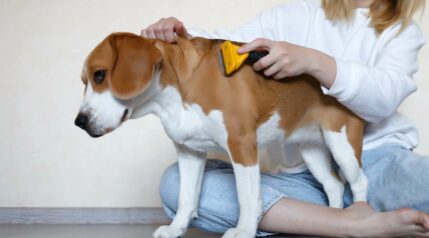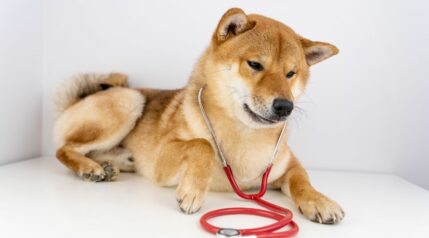The jaunty Pomeranian has been called the ideal companion. His cheerful expression and foxlike good looks have made him one of the world’s most popular breeds. Poms are the perfect size for any situation. At home by your side on an imposing estate, he’s just as happy to share your apartment life. You’ve decided he’s the pup for you, but you wonder if you can keep up with his shedding. He’s tiny, but he sure seems to have a lot of fluff. Pomeranians are considered moderate to heavy shedders. If you need to limit the amount of dog hair in your home, you might have a challenge ahead of you with a Pomeranian.
The Pom has an outgoing and curious personality. For families with children old enough to respect his small size, he’s a lively family pet. His double coat requires frequent brushing, but he’s small sufficient daily grooming is manageable. The Pomeranian sheds seasonally, so you’ll need to adjust how you care for his coat depending on the season.
Whether there’s a member of your household with a dog allergy or you’re just trying to ensure you can keep up with his grooming, how you manage your Pomeranian’s coat makes a difference. Here are some things to consider to help keep him healthy and minimize his shedding.
At A Glance: Best Products For Pomeranian Grooming

Brush For Grooming
Hartz Double-Sided

Comb For Matting
Fine-toothed Comb

Brush For Shedding
Furminator Deshedding Brush
Note: Clicking the above links take you to each company’s website to learn more and get a quote. If you make a purchase, we earn a commission at no additional cost to you.
Pomeranian Coats & Colors
Although we usually think of the Pomeranian with his reddish-orange, foxlike coat color, there are many colors Pomeranians may be. At shows, color classes include Red, Orange, Cream, and Sable, Black, Brown, and Blue, and a class for any other color and pattern. The Pomeranian’s double coat has an undercoat and outer layer to protect him against the elements. His body should be covered with a short, dense undercoat and guard hairs that form his fluffy outer coat and his impressive ruff that frames his head and extends across his shoulders and chest.
The Pomeranian’s abundant coat requires daily grooming. Poms shed seasonally and have summer and winter coats depending on the lengthening or shortening of the days. They shed most heavily when they lose their winter coat to prepare for summer’s longer, hotter days. You’ll need to brush him daily to manage the hair during shedding season.
Pomeranian Shedding Frequency

Pomeranians shed seasonally. Because they have such a thick coat, you’ll notice some hair outside the two heaviest times of the year. They will be noticeable, but daily brushing helps remove loose hairs, so there are fewer in the house.
As you may expect, as seasonal shedders, Poms shed most when they lose their heavier winter coat in mid to late spring. You’ll need to step up his grooming routine when he blows his coat in later winter. During heavy shedding season, an undercoat rake helps remove his undercoat as efficiently as possible. After applying a grooming spritz, rake him daily and bathe him to remove the old coat more quickly and minimize what falls in your home.
Hypoallergenic Dogs
You may have heard that some breeds are hypoallergenic, but any dog with hair can trigger an allergy. The proteins in your pet’s urine, saliva, or dead skin cells (known as dander), may cause people with pet allergies to have itchy, watery eyes or a stuffy nose. People with more severe allergies can become short of breath within fifteen to thirty minutes of inhaling these allergens. Sensitive people may also develop a rash on their face, neck, and upper chest.
If you have a family member allergic to pet dander, you want to find a breed with hair that won’t create health problems for your human family or a situation where you must rehome your pup. Pomeranians shed heavily and may not be suitable for allergic households. They shed hair, and they shed dander. Remember that any breed, unless hairless, will clear and produce dander.
Other Reasons For Losing Hair
Shedding is normal, but abnormal shedding can indicate a health problem. Sometimes excessive shedding originates in the skin itself. Inflammation of the skin, or dermis, is called dermatitis and can have internal or external causes.
Genetic Causes
Sebaceous Adenitis is agenetic health disorder in which inflammation in the skin’s oil-producing sebaceous glands causes the dog’s hair to fall out. You may notice dry, scaly patches with hair loss along the top of his head, back of his neck, and back when your Pom is between one and five years old. It can also cause cysts, which require a veterinary consult. Do not try to drain these yourself, as you may inadvertently spread infection. Treatment consists of fatty acid supplements and special shampoos to remove dead skin and hair.
External Causes
Several external causes of hair loss strike all dogs, regardless of breed. Flea bite dermatitis is the most common allergic skin disease in dogs. If you know you have a flea problem, putting together an effective flea management regimen is the first line of defense. If your buddy is still itchy after the fleas are gone, a visit with your vet is in order. They may perform a “skin scrape” and examine the sample under a microscope to decide the proper course of treatment.
The second most common allergic skin disease in dogs is more general. We call this skin allergy “atopy.” Pomeranians can have the condition. The feet, belly, and skin folds tend to be red and itchy, and ear infections become more common. Allergies typically appear when dogs are in early adulthood and can get worse every year. Licking the paws, rubbing the face, and frequent ear infections are the most common signs. The root of skin allergies is typically either environmental allergens or food sensitivity.
If you suspect your kibble is the source of your dog’s excessive itching and shedding, you might try a special diet with ingredients formulated not to trigger allergic reactions. Ask your vet what brands and formulas they recommend. You should be able to find a blend that keeps your Pomeranian healthy and happy at a comfortable price point.
Managing Pomeranian’s Shedding

Choosing suitable brushes for his long, fine hair ensures a pleasant grooming session for you. Because he mats easily and you’ll spend hours per week keeping his coat brushed out and mat-free, ensure your brushes have a comfortable grip. Here are the best ways to manage their coat and reduce shedding.
Brushing
Your buddy’s particular coat and the time of year dictate how much you need to brush him. When seasons change, your Pomeranian will shed more than usual and benefit from increased brushing. He could go two or three days between brushings for most of the year, but during shedding season, his coat needs daily attention to minimize the amount of hair in your home.
Types Of Brushes
Choose your grooming tools with care. A Pomeranian’s double coat requires the proper tools. Begin with a two-level steel comb sprayed with grooming spritz and work it through his coat. Mats should be untangled by hand as often as possible. A slicker brush is the next step to address sections of his hair at a time. Spray each area lightly with a spritz as you work your way through his coat. The final step is to smooth his skin with a pin brush using more grooming spritz. You’ll leave his coat smooth and glowing with health.
Shampoo
Always choose a dog-safe shampoo. Choose a shampoo specifically formulated for sensitive skin if your pup’s skin reacts to be reactive. Even with a gentle shampoo, shampooing your Pomeranian too frequently can strip the natural oils from his coat and dry his skin, so limit baths to when he needs thorough grooming or when he’s particularly dirty.
Diet
For your Pomeranian to have a healthy coat, he needs proper nutrition. Many dogs are allergic to chicken in commercial dog foods. If you’re worried your pup may have food sensitivities, try a chicken-free formula. Feeding a dog food that does not contain known allergens can reduce shedding due to inflamed skin.
Nutritional deficiencies from low-quality dog foods can cause dermatitis and excessive shedding. It may take some time, but finding quality food with ingredients your particular dog can tolerate will save you money in the long run. More importantly, it will keep your best friend from unnecessary discomfort.
The brand you choose should include omega-3 fatty acids. Omega-3 fatty acids have anti-inflammatory properties considered beneficial for dogs’ skin and coats. Research has shown omega-3s have health benefits for dogs beyond just making their coats shine. They reduce inflammation in the body, keeping your buddy more comfortable and keeping itchy skin at bay.
Supplements
Omega-3 supplements and treats make adding more omega fats into your Pom’s diet easy, but be sure not to overfeed him. Fish oils add omega-3s promote a healthy coat, and reduce shedding. Some supplements contain a blend of fish and plant-based oils to provide a balanced ratio of the three main types of omega-3 fatty acids, alpha-linolenic acid (ALA), eicosapentaenoic acid (EPA), and docosahexaenoic acid (DHA). If your Pom has food sensitivities, check the label on the treats to be sure you don’t introduce proteins that may trigger food allergies.
Air Purification
You can minimize how much your Pomeranian sheds with good nutrition and frequent grooming, but you can’t stop him from shedding. Adding air purification to your home has benefits beyond tackling dog hair, but it’s one more way to reduce the amount of hair in your home and the allergens in the air. The most significant allergen dogs introduce is dander, the dead skin cells constantly sloughing and falling along with shed hairs.
Dog dander is roughly 2.5 microns, although it may be larger. An air purifier that effectively eliminates airborne particulates smaller than this can significantly reduce the amount of pet dander available to trigger allergic symptoms. The Levoit Core 200S Air Purifier claims to capture 99.97% of airborne particles (as small as 0.3 microns), including dust, lint, dust mite debris, mold spores, pollen, pet dander, smoke, smog, bacteria, viruses, exhaust particles, and ultrafine particles. You’ll need to see if one high-capacity unit or multiple smaller units suit the layout of your home.
Vacuuming
While vacuuming is nothing fun, it is one more tool in the arsenal against pet hair. If your air purifier eliminates the airborne particulates that trigger your allergies, a mechanical vacuum can take care of anything that lands on surfaces in your home or car. The best vacuum is lightweight, so you’ll use it frequently and versatile enough to tackle multiple surfaces in your home and elsewhere.
While it is a traditional handheld stick vacuum, the Bissell Featherweight Cordless XRT also includes specialized pet tools. It converts to a handheld vacuum with a crevice tool and upholstery brush to get pet hair wherever it settles. This lightweight vacuum handles hard surfaces and area rugs but may not have the power for a home with wall-to-wall carpets. Carpet is a significant factor in how much hair and dander stay trapped in a room. You may consider the more powerful Bissell ICONPet Edge for fully carpeted homes.
Frequently Asked Questions
Do Pomeranians Shed A Lot?
Compared to other breeds of dogs, Pomeranians are heavy shedders. Depending on the season, you’ll notice a difference in how much hair he loses. You can increase the frequency you brush him to help his coat shed out more quickly.
When Is It Time To Take My Pom To The Vet?
If your dog is shedding more than expected, inspect the skin beneath his coat. Schedule a consultation with your veterinarian if his skin seems thick, greasy, scaly, red, or foul-smelling.
Final Thoughts
Nobody brings a Pomeranian into their life unless they’ve considered his beautiful thick coat. You’ve checked your list, and you have the space, the fenced yard, the time for walks, and room in the car to transport him to and from the vet. Relative to the other considerations, his shedding will be relatively manageable.
Care for your Pomeranian’s coat with the proper tools and the occasional mild shampoo. Feed him a quality diet with omega-3 fatty acids to reduce inflammation and keep his skin healthy from the inside out. Shedding is normal for a Pom. Although his body is tiny, the amount of hair he sheds is as significant as the immense love he provides you. With proper management, you’ll be able to handle it and focus on the fun you two have together.





